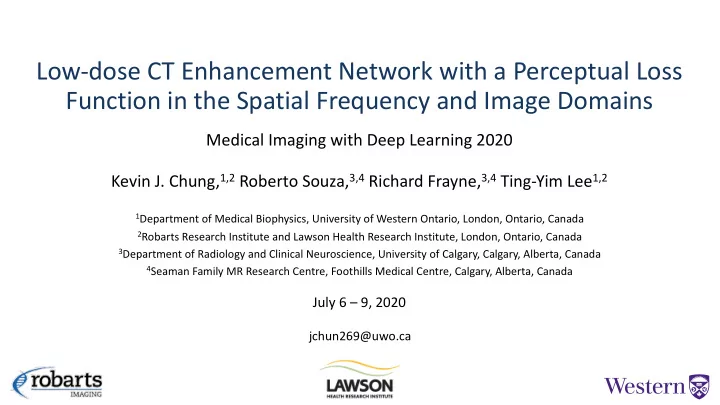

Low-dose CT Enhancement Network with a Perceptual Loss Function in the Spatial Frequency and Image Domains Medical Imaging with Deep Learning 2020 Kevin J. Chung, 1,2 Roberto Souza, 3,4 Richard Frayne, 3,4 Ting-Yim Lee 1,2 1 Department of Medical Biophysics, University of Western Ontario, London, Ontario, Canada 2 Robarts Research Institute and Lawson Health Research Institute, London, Ontario, Canada 3 Department of Radiology and Clinical Neuroscience, University of Calgary, Calgary, Alberta, Canada 4 Seaman Family MR Research Centre, Foothills Medical Centre, Calgary, Alberta, Canada July 6 – 9, 2020 jchun269@uwo.ca
Low-dose Computed Tomography Image Domain Frequency Domain • Ionizing radiation dose from CT is a central consideration for safe imaging • Low-dose CT increases noise and impedes the readability of the scan Routine-dose CT (RDCT) • Iterative or deep learning reconstruction can improve signal-to-noise • Real projection data is often proprietary and limits data for model development Low-dose CT (LDCT) High spatial frequencies 2
Network Structures and Training Protocol • Data from AAPM Low-dose CT Challenge Network Configurations FBP LDCT Denoised LDCT • 5/2/3 patients training/validation/testing split I U-net (4,748/1,193/2,373 axial images) Image • Min-max normalization (0 to 1.0) of network inputs U-net F U-net Fourier • Trained end-to-end for 30 epochs using the LDCT Spectrum U-net U-net Structure 2D iFFT 2D FFT Adam optimizer with a learning rate of 10 -4 II W-net Image Image U-net U-net • Early stopping of 10 and real-time data augmentation of training images to reduce RDCT Reference FF W-net model overfitting Fourier Fourier U-net U-net 2D FFT 2D iFFT FI W-net • Loss function: weighted sum of multi-scale Fourier Image structural similarity and absolute error U-net U-net 2D FFT 2D iFFT IF W-net Image Fourier • ~11.5m parameters per U-net U-net U-net 2D FFT 2D iFFT 3
Routine-dose CT I U-net F U-net FI W-net Results n.s. n.s. n.s. SSIM: 0.939 SSIM: 0.933 SSIM: 0.945 PSNR: 40.58 PSNR: 41.01 0.8 0.85 0.9 0.95 1 PSNR: 39.19 Structural Similarity NRMSE: 0.94 NRMSE: 0.89 NRMSE: 1.10 Low-dose CT II W-net FF W-net IF W-net n.s. n.s. n.s. SSIM: 0.857 SSIM: 0.926 SSIM: 0.938 SSIM: 0.943 PSNR: 35.76 PSNR: 39.19 PSNR: 40.56 PSNR: 40.80 30 35 40 45 50 Peak Signal-to-Noise [dB] NRMSE: 1.63 NRMSE: 0.94 NRMSE: 1.10 NRMSE: 0.91 0.017 0.0078 Training loss 0.021 Validation loss 0.0118 0.0076 0.015 0.019 Low-dose 0.0113 n.s. MS-SSIM + L1 Loss 0.0074 I U-net 0.0108 0.013 0.0072 0.017 II W-net 24 26 28 30 24 26 28 30 n.s. F U-net 0.011 0.015 FF W-net FI W-net n.s. 0.009 0.013 IF W-net 0 0.5 1 1.5 2 0.007 0.011 Normalized RMSE [%] 4 4 0 5 10 15 20 25 30 0 5 10 15 20 25 30 Epoch
Discussion and Conclusions • Dual-domain approaches were quantitatively superior to single-domain U-nets and W-nets • Minimal qualitative differences between image-domain and dual-domain approaches • Poor qualitative results of the spatial frequency domain networks were likely a result of optimizing the perceptual loss of the frequency spectrum • Denoised images appear overly smoothed compared to routine-dose references and differ in noise characteristics • Data quality and quantity is a limiting factor for denoising performance 5
Recommend
More recommend